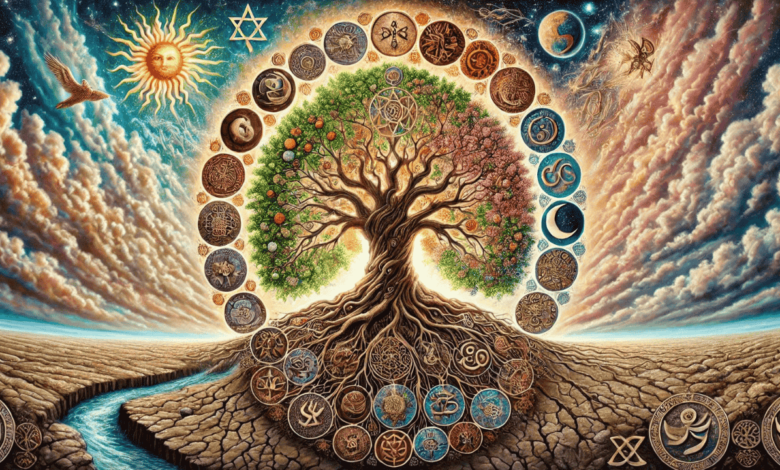Understanding the Tree of Life: A Symbol of Unity and Growth in Art and Culture

The Tree of Life is a powerful and ancient symbol that spans across various cultures, religions, and artistic expressions. It represents the interconnectedness of all life, symbolizing growth, strength, and unity. Over centuries, it has evolved to embody numerous meanings, from spiritual wisdom to life cycles and the connection between the physical and metaphysical realms. The tree’s roots in the earth and branches reaching toward the heavens make it a compelling visual metaphor for the human condition and the universe. This article will explore the origins, symbolism, and enduring presence of the Tree of Life in art and culture.
The Ancient Origins of the Tree of Life
The Tree of Life can be traced back to some of the earliest human civilizations, where it appeared in mythologies and sacred texts. Its significance is often centered on its depiction as the axis mundi, or the world tree, that connects the heavens, earth, and the underworld.
Tree of Life in Ancient Civilizations
- Mesopotamian Influence:
The Sumerians are credited with one of the earliest representations of the Tree of Life, often shown as a central figure in religious carvings, representing fertility and divine power. - Egyptian Mythology:
In ancient Egypt, the Tree of Life was associated with eternal life and the gods. The sacred sycamore tree was considered a divine provider of nourishment to the dead in the afterlife. - Celtic Traditions:
The Celts held the Tree of Life, or Crann Bethadh, in high regard. For them, it symbolized the connection between the earth and the spirit world, representing harmony, balance, and rebirth.
The Symbolism of the Tree of Life
The Tree of Life has become synonymous with numerous aspects of human existence, spiritual growth, and the cycle of life. Its broad branches reaching for the sky, combined with deep-rooted foundations, make it a perfect symbol of balance and connection between different realms.
Key Symbolic Meanings
- Interconnectedness:
The Tree of Life symbolizes the connection of all living things, emphasizing how every life form is part of a larger, interconnected system. - Growth and Renewal:
As a living organism, trees grow, change, and renew with the seasons, representing the continuous cycle of life, death, and rebirth. - Strength and Stability:
With deep roots that anchor it firmly in the ground, the tree signifies stability, resilience, and inner strength, qualities that are essential for personal growth. - Spiritual Wisdom:
The Tree of Life also represents spiritual wisdom and enlightenment, as its branches stretch toward the divine while its roots remain grounded in the physical world.
The Tree of Life in Different Religions
- Judaism and Christianity:
The Tree of Life plays a crucial role in both Judaism and Christianity, particularly in the story of the Garden of Eden. In this narrative, it represents eternal life and the wisdom of God. - Islam:
Known as the Sidrat al-Muntaha, the Tree of Life in Islamic tradition represents the limit of human understanding and divine knowledge. It is often depicted as a boundary between heaven and earth. - Hinduism and Buddhism:
In these traditions, the tree symbolizes the pathway to enlightenment. In Hindu mythology, the Banyan tree is seen as a representation of immortality, while in Buddhism, the Bodhi Tree is where Siddhartha Gautama attained enlightenment and became the Buddha.
The Tree of Life in Art
The Tree of Life has been an enduring motif in art throughout history. Artists across different cultures have been captivated by its symbolism and used it to express themes of growth, spirituality, and connection.
One of the most famous modern depictions is Gustav Klimt’s Tree of Life, which showcases the tree’s flowing branches and intricate design, representing the interconnectivity of life. This particular tree of life painting has inspired numerous interpretations, reflecting both personal and universal themes of growth and unity.
Today, the Tree of Life is a popular theme in modern art, jewelry, and home décor, often representing personal growth, family bonds, and spirituality. Its iconic image continues to resonate with people who seek deeper meaning in their lives and surroundings.
The Tree of Life in Popular Culture
Beyond religious and artistic contexts, the Tree of Life has also made its way into popular culture. Its image is frequently used in fashion, tattoos, and personal symbols, often representing a connection to nature, family heritage, or spiritual growth. Additionally, the tree’s symbolism of unity and interconnectedness is increasingly relevant in today’s globalized world, where the awareness of humanity’s interdependence continues to grow.
Conclusion
The Tree of Life is one of the most enduring symbols in human history, bridging the gap between the physical and spiritual worlds. Its representation of interconnectedness, growth, and renewal makes it a universal symbol that resonates across cultures and art forms. Whether in ancient carvings, religious texts, or modern art, the Tree of Life continues to inspire and remind us of our shared human experience and the natural world around us.




